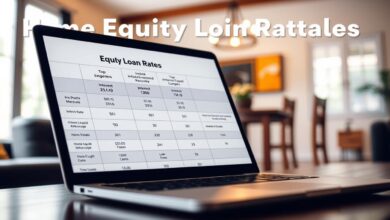Best Home Loans Options in the US for You
Navigating today’s housing market requires clear financing solutions tailored to your budget and goals. Whether you’re buying your first property or upgrading, understanding your mortgage choices is crucial. Major lenders like Bank of America and Wells Fargo now offer flexible programs with amounts ranging from $60,000 to $2.5 million, opening doors for diverse buyers.
Current rate options include 30-year fixed terms for predictable payments and 15-year plans to build equity faster. Adjustable-rate mortgages (ARMs) provide lower initial rates, ideal for shorter-term ownership. Your ZIP code and down payment—often starting at 5%—directly influence monthly costs. For example, a $200,000 loan in area 95464 shows how location impacts terms.
Digital tools simplify comparisons: calculate payments online, prequalify instantly, or lock rates in real time. This streamlined process removes guesswork while educating borrowers on key terms like APR and closing costs. With transparent information and modern convenience, securing the right loan has never been easier.
Key Takeaways
- Leading lenders offer financing from $60k to $2.5M with down payments as low as 5%
- Compare fixed-rate stability vs. adjustable-rate flexibility for your timeline
- Local housing markets (like ZIP 95464) affect interest rates and eligibility
- Online calculators provide instant estimates for monthly payments
- Prequalification tools help gauge budget limits without credit checks
Understanding Home Loans in the United States
When you’re stepping into the world of property ownership, understanding your mortgage terms is key. These agreements let you borrow funds using the property as collateral, with repayment plans spanning 15 to 30 years. The interest rate you secure affects your monthly costs, but the APR (Annual Percentage Rate) tells the full story—it adds fees like closing costs and insurance to show the true borrowing expense.
Your monthly payment isn’t just about repaying the borrowed amount. It combines three parts: principal (the original sum), interest (the lender’s charge), and often mortgage insurance if your down payment is below 20%. For example, a $300,000 loan at 6% interest might cost $1,800 monthly before adding insurance or taxes.
Lenders evaluate your credit score, job history, and existing debts to decide your eligibility. A stable income and debt-to-income ratio below 43% improve your chances for better terms. Government-backed options like FHA loans help buyers with smaller savings, while conventional programs suit those with stronger finances.
Choosing the right financing requires balancing short-term affordability with long-term costs. Tools like online calculators let you test different rates and timelines. Always compare offers from multiple lenders—this information empowers you to negotiate confidently and avoid overpaying over decades.
Exploring Mortgage Types: Fixed-Rate, ARM, and More
Choosing the right mortgage type shapes your financial journey for years. Two primary options dominate the market: fixed-rate and adjustable-rate agreements. Each serves different goals, from long-term stability to short-term savings.
Fixed-Rate Mortgage Features
Fixed-rate mortgages lock your interest rate for the entire term. Whether you choose 15 or 30 years, your principal and interest payment stays predictable. Shorter terms like 15-year plans save thousands in interest but require higher monthly contributions.
For example:
| Term | Interest Rate | Monthly Payment* | Total Interest |
|---|---|---|---|
| 30-year | 6.5% | $1,896 | $382,632 |
| 15-year | 6.0% | $2,532 | $155,760 |
*Based on $300,000 loan amount
Adjustable-Rate Mortgage Explained
Adjustable-rate mortgages (ARMs) start with lower initial rates than fixed options. After a set period—often 5 years—the rate adjusts based on indexes like SOFR. Bank of America’s ARMs use this index, with caps limiting increases to 2% per adjustment and 5% lifetime.
Consider this scenario: A 5/1 ARM starts at 4.5% for five years. If rates rise 1.5% at adjustment, your payment increases by $225 monthly on a $300,000 balance. These work best if you plan to sell or refinance early.
“Your mortgage choice should align with both your current budget and future plans.”
Evaluate your timeline and comfort with risk. Fixed rates suit those prioritizing stability, while ARMs reward strategic, shorter-term ownership.
Exploring Home Loans Options: A Comprehensive Guide
Selecting the right financing path involves matching your financial profile to specialized programs. Lenders now offer tailored solutions for everything from luxury properties to first-time purchases, each with unique perks and requirements.
Jumbo mortgages help buyers in competitive markets finance properties exceeding $766,550 (2024 conforming limits). These often come with slightly higher rates but provide fixed or adjustable terms for flexibility. For example, a $1.2 million property in Los Angeles might use this option with a 10% down payment.
First-time buyers benefit from programs like the Affordable Loan Solution, requiring just 3% down. This opens doors for teachers, nurses, and others with steady incomes but limited savings. Combined with local down payment assistance, it’s transformed homeownership accessibility in cities like Nashville and Phoenix.
Government-backed choices shine for specific groups. FHA options accept credit scores as low as 580 with 3.5% down, while VA programs eliminate down payments entirely for qualified veterans. “These products exist to level the playing field,” notes San Diego mortgage advisor Lisa Moreno. “Your service history or career shouldn’t block your housing dreams.”
Medical professionals get special treatment through doctor-specific mortgages. These often ignore student loan debt in eligibility calculations and allow 0% down for residents. A Chicago surgeon might secure $800,000 financing despite $300,000 in education loans.
Compare these options using lender checklists: note minimum credit scores, required documentation, and rate locks. A side-by-side analysis reveals which program aligns with your five-year plan and budget.
Decoding Loan Interest Rates and APR
Your borrowing costs boil down to two numbers: the interest rate flashing in ads and the APR hiding in fine print. While they look similar, these figures tell different stories about what you’ll actually pay.
How Interest Rates Are Calculated
Lenders set your rate using a financial recipe. Your credit score acts as the main ingredient—scores above 720 often secure the best terms. They also mix in your debt-to-income ratio, down payment size, and loan duration. A 20% down payment might trim 0.5% off your rate compared to 5%.
Market trends stir the pot too. When the Federal Reserve raises rates, lenders often follow. Last month’s average 30-year fixed rate jumped from 6.3% to 6.7% following economic reports.
Understanding APR Components
The APR reveals the full picture by adding fees to your base interest. For a $300,000 mortgage:
| Fee Type | Cost |
|---|---|
| Origination | $2,400 |
| Points (0.5) | $1,500 |
| Insurance | $900/year |
These extras convert a 6.5% rate into a 6.8% APR. “Always compare APRs,” advises financial planner Rachel Torres. “A lower rate might mask $8,000 in hidden costs over five years.”
Discount points offer rate reductions—pay 1% upfront to slice 0.25% off your interest. On a $400,000 loan, $4,000 buys a 6.25% rate instead of 6.5%. Run break-even calculations to see if this trade-off makes sense for your timeline.
Managing Monthly Payments and Closing Costs
Planning your housing budget starts with two critical numbers: what you pay each month and what you spend upfront. These figures determine affordability and long-term financial comfort. Let’s break down how to calculate them accurately.
Estimating Your Monthly Payment
Your base monthly payment includes three parts: principal repayment, interest charges, and mortgage insurance (if your down payment is under 20%). Here’s how a $300,000 loan at 6% interest breaks down:
| Component | Amount | Details |
|---|---|---|
| Principal | $500 | Reduces loan balance |
| Interest | $1,500 | Borrowing cost |
| Insurance | $150 | Required for |
Actual payments climb higher when adding property taxes and hazard insurance. A $2,000 annual tax bill adds $167 monthly, while $1,200/year insurance tacks on $100. Always use calculators that include these extras.
Understanding Closing Costs and Fees
Upfront expenses typically range from 2-5% of your loan amount. For a $400,000 purchase:
- $1,200 appraisal fee
- $850 title insurance
- $2,500 origination charges
Programs like Wells Fargo’s Dream Plan Home offer credits up to $5,000 for eligible buyers. “These incentives make ownership achievable for teachers and healthcare workers,” explains mortgage officer Carlos Rivera.
To reduce surprises, request a closing cost estimate during preapproval. Compare lender fees side-by-side—differences often exceed $3,000. Smart planning turns these upfront hurdles into manageable steps.
Mortgage Insurance, Property Taxes, and Additional Fees
When budgeting for a property, don’t overlook mortgage insurance and tax obligations that shape your long-term costs. These factors influence both your monthly payments and overall affordability, often catching unprepared buyers off guard.
The Impact of Insurance and Taxes on Your Loan
Mortgage insurance becomes mandatory when your down payment falls below 20%. Your monthly payment includes this added cost until you build 20% equity through regular installments or property value growth. This protection shields lenders—not borrowers—if payments stop.
Local governments determine property taxes based on your residence’s value and community needs. A $300,000 house might incur $3,600 annually in low-tax areas versus $7,200 in high-demand neighborhoods. These funds directly support schools, roads, and emergency services.
Lenders require homeowners insurance to protect their investment from disasters and theft. Premiums fluctuate based on coverage levels and regional risks—coastal properties often pay 58% more than inland counterparts for storm protection.
Most lenders bundle tax and insurance payments into escrow accounts. This system ensures your payment includes these obligations through manageable monthly increments. While skipping escrow might offer flexibility, it frequently increases interest rates by 0.25% or more.
Flexible Loan Options for Diverse Borrowers
America’s housing landscape thrives on specialized programs catering to unique financial situations. Whether you’re eyeing a luxury estate or seeking entry-level affordability, tailored solutions exist to match your needs. Lenders now prioritize flexibility, offering structures that adapt to varying incomes, credit histories, and property types.
Jumbo Loans and Government-Backed Mortgage Programs
Jumbo mortgages unlock opportunities in high-cost areas where prices exceed standard limits. These products cover properties above $766,550, with fixed or adjustable rates. A San Francisco buyer might secure $1.5 million financing through this option, often requiring 10-20% down payments and strong credit profiles.
Government initiatives level the playing field for those with limited savings or imperfect histories:
- FHA loans accept 3.5% down payments and credit scores as low as 580
- VA programs remove down payment requirements for military families
- USDA financing supports rural purchases with 100% funding
Medical professionals benefit from unique career-specific mortgages that ignore student debt in eligibility checks. “These programs recognize the earning potential of residents and specialists,” explains Denver loan officer Mia Patel. “They’re designed to help essential workers build stability through ownership.”
Comparing options starts with understanding your priorities. Jumbo loans suit high earners in competitive markets, while FHA/VA plans empower first-time buyers. Tools like down payment assistance grants and rate-lock extensions add layers of customization for diverse circumstances.
Refinance, Debt Consolidation, and Home Equity
Unlocking your property’s value can provide pathways to reshape your financial landscape. Whether streamlining payments or funding major expenses, strategic refinancing and equity solutions offer tailored options. Let’s explore when these tools make sense for your goals.
When to Consider Refinancing Your Mortgage
Refinancing shines when rates drop significantly—saving hundreds monthly on a large mortgage. It also helps shorten your term from 30 to 15 years, accelerating equity growth. Cash-out options let you consolidate high-interest debt, though this increases your loan amount and resets repayment timelines.
Wells Fargo’s home equity lines of credit (HELOCs) provide flexible access to funds for renovations or emergencies. However, securing debt against your property requires caution—missed payments risk foreclosure.
Leveraging Home Equity for Financial Flexibility
Your home’s equity becomes a powerful tool once you’ve built substantial ownership. Second mortgages or HELOCs let you borrow against this value at lower rates than credit cards. Military families should consult legal advisors first—some programs offer exclusive refinance benefits.
Remember: Every debt consolidation strategy has trade-offs. Compare closing costs against potential savings, and prioritize keeping your mortgage affordable long-term. Smart equity use today can fund tomorrow’s opportunities.









